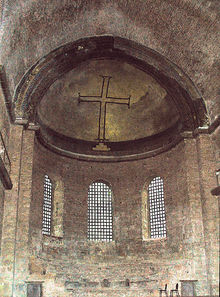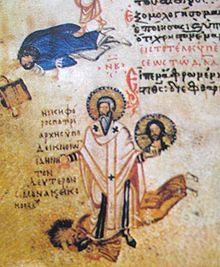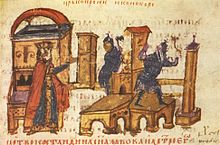비잔틴 성상파괴운동
보이기


비잔틴 성상파괴운동(Byzantine Iconoclasm; Εἰκονομαχία, Eikonomachía, 문자적의미로, "형상투쟁" or "형상에 대한 투쟁")은 동로마 제국의 역사에서 동방 정교회의 종교 지도자들에 의해서 그리고 세속 제국의 권력자들에 의해서 종교적 모양이나 형상의 사용이 반대를 받은 것을 말한다. 첫 번째 성상파괴운동은 레온 3세에 의해서 시작되었다. 두 번째 성상파괴운동은 814년에서 842년까지 있었다. 황제가 교회의 수장인 황제교황주의체제[2]로 발전한 비잔틴제국에서는 황제와 교회가 대립하는 경우가 잦았는데, 황제는 성직자를 견제하고 교회에 대한 간섭의 기회로 삼기 위해 성상사용을 금지하는 이른바 성상파괴(Iconoclast)운동을 일으켰다.[3] 성상파괴라는 말인 Iconoclasm은 그리스어 εἰκονοκλάστης에서 왔는데, εἰκονο- icono- [형상] + κλάστης - [파괴자]를 의미한다.









같이 보기
[편집]- 성상 파괴 운동
 위키인용집에 비잔틴 성상파괴운동 관련 문서가 있습니다.
위키인용집에 비잔틴 성상파괴운동 관련 문서가 있습니다.- Aniconism in Christianity
- Feast of Orthodoxy
- Libri Carolini
각주
[편집]- ↑ Byzantine iconoclasm
- ↑ 유스티니니아누스 대제 때 이루어진 제도다.
- ↑ [네이버 지식백과] 성상파괴운동, <초기 기독교 이야기>, 살림출판사
참고 문헌
[편집]- Beckwith, John, Early Christian and Byzantine Art, Penguin History of Art (now Yale), 2nd edn. 1979, ISBN 0140560335
- Brubaker, L. and Haldon, J. (2001), Byzantium in the Iconoclast Era, c. 680-850: the Sources Birmingham
- Cormack, Robin, Writing in Gold, Byzantine Society and its Icons, 1985, George Philip, London, ISBN 054001085-5
- Kitzinger, Ernst (1977), Byzantine art in the making: main lines of stylistic development in Mediterranean art, 3rd-7th century, Faber & Faber, ISBN 0571111548 (US: Cambridge UP, 1977)
- Mango, Cyril (1977), "Historical Introduction," in Bryer & Herrin, eds., Iconoclasm, Centre for Byzantine Studies, University of Birmingham, ISBN 0704402262
- Mango, Cyril (2002), The Oxford History of Byzantium
- Noble, Thomas F. X., Images, Iconoclasm, and the Carolingians, 2011, University of Pennsylvania Press, ISBN 0812202961, 9780812202960, google books
- Pratsch, T., Theodoros Studites (759–826): zwischen Dogma und Pragma (Frankfurt am Main, 1997)
추가 자료
[편집]- Leslie Brubaker, Inventing Byzantine Iconoclasm, Bristol Classical Press, London 2012.
- L. Brubaker and J. Haldon, ‘’Byzantium in the Iconoclast Era, c. 680-850’’ Cambridge: Cambridge University Press, 2011.
- A. Cameron, "The Language of Images: the Rise of Icons and Christian Representation" in D. Wood (ed) The Church and the Arts (Studies in Church History, 28) Oxford: Blackwell, 1992, pp. 1–42.
- H.C. Evans & W.D. Wixom (1997). 《The glory of Byzantium: art and culture of the Middle Byzantine era, A.D. 843-1261》. New York: The Metropolitan Museum of Art. ISBN 9780810965072.
- Fordham University, Medieval Sourcebook: John of Damascus: In Defense of Icons.
- A. Karahan, "Byzantine Iconoclasm: Ideology and Quest for Power". In: Eds. K. Kolrud and M. Prusac, Iconoclasm from Antiquity to Modernity, Ashgate Publishing Ltd: Farnham Surrey, 2014, 75-94. ISBN 978-1-4094-7033-5.
- R. Schick, The Christian Communities of Palestine from Byzantine to Islamic Rule: A Historical and Archaeological Study (Studies in Late Antiquity and Early Islam 2) Princeton, NJ: Darwin Press, 1995, pp. 180–219.
- P. Brown, "A Dark-Age Crisis: Aspects of the Iconoclastic Controversy," English Historical Review 88/346 (1973): 1–33.
- F. Ivanovic, Symbol and Icon: Dionysius the Areopagite and the Iconoclastic Crisis, Eugene: Pickwick, 2010.
- E. Kitzinger, "The Cult of Images in the Age of Iconoclasm," Dumbarton Oaks Papers 8 (1954): 83–150.
- Yuliyan Velikov, Image of the Invisible. Image Veneration and Iconoclasm in the Eighth Century. Veliko Turnovo University Press, Veliko Turnovo 2011. ISBN 978-954-524-779-8 (in Bulgarian).
- Thomas Bremer, "Verehrt wird Er in seinem Bilde..." Quellenbuch zur Geschichte der Ikonentheologie. SOPHIA - Quellen östlicher Theologie 37. Paulinus: Trier 2015, ISBN 978-3-7902-1461-1 (in German).
